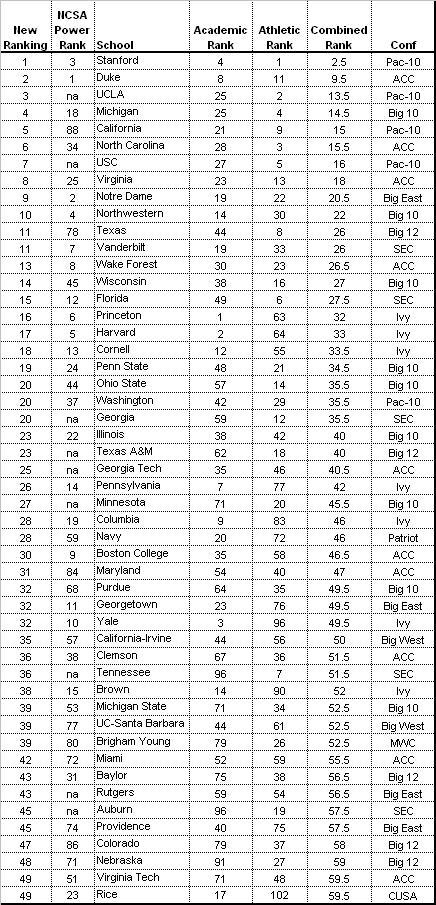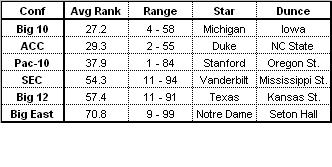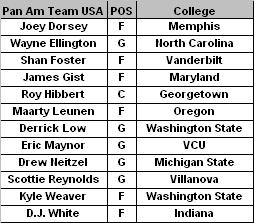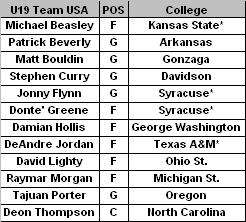10.19.07 Fast Breaks
Posted by rtmsf on October 19th, 2007More news and notes from a busy first week of practice.
- Everyone is piling on Kelvin Sampson for his phone indiscretions. AOL Fanhouse looks into the poor cell phone service excuse, while DeCourcy takes shots at IU’s compliance office. One blogger wrote an open letter to Kelvin Sampson asking him to just go away. Yesterday Sampson resisted talking about the issue at his press conference.
- Speaking of Indiana coaches causing trouble, the NCAA instituted a point of emphasis this year on abusive behavior by coaches on the sideline. M2M has the definitive take on this.
- More IU-related content: Bob Knight felt the need to talk about the MLB playoffs during his presser this week.
- Basketball Prospectus is up and running (woohoo!) – the first post that captured our attention was this one on what makes an assist an assist?
- MJ expects to watch his son
sit the benchplay at least once this year in Champaign. - On Monday it was official that Mike Hopkins would succeed Jim Boeheim at Syracuse upon his retirement; by Tuesday, it wasn’t official anymore.
- So what really went down in practice between OJ Mayo and Daniel Hackett? Was it an errant ‘bow or a flat-out haymaker to the schnozz?
- One of the underrated coaches at an underrated program, Randy Bennett at St. Mary’s got a two-year extension (through 2013).
- Katz dissects the budding UCLA-USC rivalry, comparing it to UNC-Duke. What he fails to mention is that SoCallers don’t care about college hoops nearly as much as the NCers. That’s a Laker area, through and through.
- Injuries, Suspensions, etc.
- Is Brook Lopez planning on playing this year? He’s already out for the first nine games – now he’s indefinitely suspended for breaking team rules, which means he can’t even practice.
- Wisconsin starter Michael Flowers is going on a leave of absence for the cryptic reason of “medical problems.”
- Notre Dame super-soph Luke Harongody will miss 3-6 weeks with damage to his thumb ligaments.
- Mizzou senior forward Darryl Butterfield was arrested for domestic assault and suspended indefinitely by the team.
- Remember our pal Frank Tolbert? The good state of Alabama did not agree with local prosecutors that Tolbert was drunk while
stealingdriving his SUV away from the towing lot. He is not expected to miss any games. - A bunch of UK players are injured in various ways. Oh, and Alex Legion isn’t hurt, but his mom is some kind of prophet.
- And more preseason chatter from various sources.
- MSNBC has its preseason top 25 out (UNC #1).
- Luke Winn spent the week slurping up whatever they’re selling in the RTP these days.
- Meanwhile, Jeff Goodman did a Tennessee three-step – Memphis, Vandy & UT.
- SEC:TGTBTD has it’s all-SEC teams ready – 3d Team, 2d Team, 1st Team (Chris Lofton, Jamont Gordon, Patrick Beverly, Richard Hendrix, Shan Foster).
- Gary Parrish has his all-american teams + 10 ready (we like his balls to put Derrick Rose on the first team).
- Big 12 talk – apparently K-State is loading up on players, while KU is striking out on recruiting. Yahoo asks if the Big 12 will ever win a title again, and oh yeah, Tom Osborne is the new AD at Nebraska.
- Will Florida even make the NCAA Tourney this year? Billy D. isn’t sure.
- Can UConn’s AJ Price stay away from the computer lab this year? Jim Calhoun thinks he can.






















































